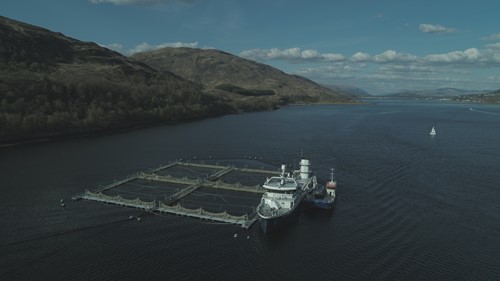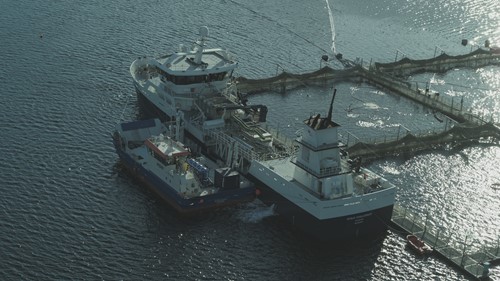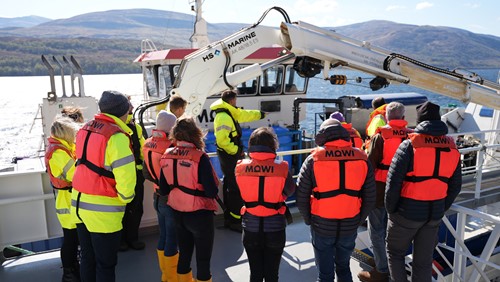Use of CleanTreat® water treatment technology to support Integrated Pest Management
This project explored the use of a water treatment technology (CleanTreat®) to support salmon farmers in their approach to Integrated Pest Management (IPM), to unlock additional site capacity and enhance fish health and welfare.
Anticipated Benefits
This pilot project represents a huge leap forward in the efforts of salmon producers to reduce environmental discharge, and in the work to promote sustainable industrial growth and environmental stewardship, both in the UK and internationally.
£632k
Total Value
Partners
-
Benchmark Animal Health Ltd
-
Mowi Scotland Ltd
- The Institute of Aquaculture at the University of Stirling
Case study
Download Full Case Study PDF
These highly significant findings could be a first step to enable the Scottish salmon industry increased access to an effective sea lice medicine, helping farmers while also protecting the environment.
Neil Robertson, Head of Operations at Benchmark Animal Health
The use of a water treatment technology (CleanTreat®) to support salmon farmers in their approach to Integrated Pest Management (IPM) to unlock additional site capacity and enhance fish health and welfare
Partners: Benchmark Animal Health Ltd, University of Stirling, and Mowi Scotland Ltd
Project Leads: Joshua Holder, Trevor Telfer and Dougie Hunter

CleanTreat® system workboat alongside the wellboat (front). Image credit: Benchmark Animal Health
Background
The Scottish Government has projected a target to double the value of Scottish Aquaculture from £1.8 billion per year in 2016 to £3.6 billion in 2030. Key factors in achieving this ambition will be a notable increase in the overall number of farm sites and/or an increase in the biomass permitted at existing sites. Currently, salmon farming in the UK is restricted from significant growth by the presence of sea lice; a marine ectoparasite that feeds on the mucus, tissue, and blood of salmonid hosts, causing lesions, secondary infections, reduced feed conversion ratios, and mortality in severe cases. Managing sea lice costs approximately £40 million annually in Scotland and is considered one of the greatest biological challenges to sector growth.
Sea lice management involves the development of site-specific Integrated Pest Management (IPM) strategies that detail a range of tools available for lice mitigation, including a variety of medicines. The Scottish Environment Protection Agency (SEPA) implements licences on a site-by-site basis to farms, limiting the use of therapeutic treatments to ensure environmental health is maintained. In some cases, restrictive discharge criteria can limit the ability to effectively treat farms with certain medicines using tarpaulin and/or wellboat treatments, which can reduce the overall ability to manage parasites and promote resistance to medicines within pest populations.
CleanTreat® is a purification system, developed in Scotland and successfully operating in Norway, to remove medicines from treatment water before safe transfer back to sea, and has the potential to be applied to medicines used within the UK industry. In a pilot study performed in Scotland in 2022, CleanTreat® was used to treat water containing Salmosan® Vet (active ingredient azamethiphos; with Benchmark Animal Health the Marketing Authorisation holder) at a Scottish salmon farm to investigate the performance at field scale of CleanTreat® reducing the discharge of Salmosan® Vet into the environment. Discharges purified via CleanTreat® were modelled and compared against existing practices, demonstrating the potential environmental and productivity gains to be made through the scale-up of this innovation.
This project represents the first field use of CleanTreat® in Scotland and the first use globally with Salmosan® Vet, laying the groundwork for more environmentally sustainable sea lice management. Collaborators for this work include Benchmark Animal Health Ltd, a leading provider of specialised health solutions for aquaculture; the University of Stirling’s Institute of Aquaculture, with a research team led by an expert in marine environmental resource assessment, Professor Trevor Telfer; and Mowi Scotland, the UK’s largest supplier of farmed salmon.

CleanTreat® system workboat alongside the wellboat (back). Image credit: Benchmark Animal Health
Aims
The overarching aim of the project was to demonstrate the use of the CleanTreat® purification technology within Scotland alongside the licensed therapeutant, Salmosan® Vet. Furthermore, to develop an understanding of the efficiency and characteristics of the removal of the Active Pharmaceutical Ingredient (API), azamethiphos, and the challenges in operating alongside wellboats in a commercial environment.
Environmental modelling and risk assessments
Using hydrodynamic modelling output coupled with a single point discharge model, and the traditional BathAuto, the University of Stirling’s research team modelled five sites across Scotland with different characteristics in order to compare predictions for the maximum amount of Salmosan® Vet that can be used and ultimately discharged from (a) traditional tarpaulin treatment, (b) wellboat treatment, and (c) wellboat treatment with varying levels of purification by CleanTreat®. Through this, environmental risk assessments were developed to demonstrate the potential impact on Scottish salmon production by using a purification technology with bath treatments for sea lice.
Work done
This work package comprised the environmental modelling and risk assessment for a number of scenarios for use of CleanTreat® when using azamethiphos treatments in a wellboat with a consequent point source discharge (a single pipe), and when using tarpaulin-based treatments in a fish cage.
A range of levels of partial CleanTreat® treatments were modelled to assess environmental interactions. These were compared to a full azamethiphos concentration scenario, using farm sites that exhibit a range of environmental conditions, from sheltered environments to dynamic marine systems.
These models were used to estimate the resulting environmental concentrations for the treatment scenarios to assess the environmental risk based on standard Environmental Quality Standards (EQS) – 100m mixing zone concentrations and area for 0.04 ug/L concentrations.
Outcomes
The modelling for the CleanTreat® discharge at the trial site, under the scenario – of a wellboat treatment with varying levels of purification by CleanTreat® showed a scaled decrease in environmental loading when compared to the regulatory EQSs for point source or bath treatment discharge, at all sites modelled. This is proportional to the amount of treatment removed and the hydrodynamic properties of the individual sites.
The CleanTreat® system has been shown to reduce discharge concentration and subsequent modelled environmental concentrations, which could give potential for a re-assessment of discharge consent limits with respect to azamethiphos being used with CleanTreat®. This could lead to improved environmental conditions or the potential for regulators to consider allowing an increased number of treatments with reduced medicine discharge and environmental effect.
Regulatory engagement and technical development of the pilot CleanTreat® System
Ahead of field trials, Benchmark Animal Health Ltd and Mowi engaged with SEPA to ensure the compliance of trial work with environmental regulations, and to gain insight on the regulatory perspective of the expected project outputs .
Through discussions, it was determined that the pilot CleanTreat® system would be based onboard a wellboat or alternative support vessel and discharge water within the existing Controlled Activities Regulations (CAR) license.
The CleanTreat® Pilot system was therefore designed as a modular unit to be positioned on the main deck of a workboat, which would be situated alongside a wellboat. Post-treatment water could then be transferred, via hard pipe connections, from the wellboat treatment wells to the CleanTreat® system onboard the workboat.
Purification field trials
In order to assess the purification performance of the CleanTreat® pilot plant, research teams developed a trial regime, taking into account a range of operational parameters, to feed seawater dosed with Salmosan® Vet through the system followed by analysis of effluent water to assess the quantity and percentage of azamethiphos removal. It was decided that trial work should take place with ‘dosed seawater’, i.e. without fish, so that key learnings on the CleanTreat® system performance and operation could be gained without unnecessarily treating fish. This approach avoided treating fish that may not have required treatment for sea lice during the time of the trial.

Team visit to the site. Image credit: Benchmark Animal Health
Work done
The initial step in the operation of the CleanTreat® pilot plant was applying an appropriate dose of Salmosan® Vet to the treatment wells by using water-soluble pouches added to the recirculation stream via the CO2 strippers on the wellboat.
The workboat travelled to the trial site daily, on arrival the system was connected to the wellboat and flushed with seawater to check connections before switching to operate with ‘dosed’ treatment water.
Water samples were analysed via HPLC-UV* to enable the quantification of azamethiphos levels across a wide range, from targeted doses down to trace residue quantities.
*High-performance liquid chromatography (HPLC) is a technique in analytical chemistry used to separate, identify, and quantify each component in a mixture.
Outcomes
Throughout the course of the trial, the CleanTreat® system purified post-treatment water to azamethiphos concentrations between the quantifiable limit of the HPLC method* (0.0006 µg/L) and 6.8µg/L.
A total of 1680g of Salmosan® Vet (840g azamethiphos) was dosed with an average removal efficiency in excess of 90% across the 8100m3 treated.
Impact
This pilot-scale project successfully demonstrated the validity of CleanTreat® technology for purifying Salmosan® Vet wellboat treatment water to an average removal efficiency of more than 90% of the original azamethiphos concentration. The work carried out within this project sets the foundation for a commercial-scale trial with ‘live’ treatments and ultimately opens the future possibility for Scottish producers with limited discharge consents to treat more effectively for sea lice using Salmosan® Vet.
The commercial impact of implementing CleanTreat® water purification technology would serve to support the targeted use of medicines within IPM strategies; helping to widen the variety of lice management tools available to farmers, increase overall production performance, and to improve fish health and welfare, all while supporting the Scottish Government’s aim of environmentally sustainable food production. Furthermore, the ability to implement more effective dosages and medication rotations will help to reduce the development of medication resistance within sea lice populations.
The critical technical knowledge gained and the data generated from this trial was the first step in evaluating the CleanTreat® systems for commercial use alongside Salmosan® Vet in the Scottish market. In addition to future trials including purification of treatment water where fish were present, a market assessment and industry engagement is required to evaluate how best this solution can be successfully brought to market. Introducing a wellboat plus CleanTreat® model targeting an average removal efficiency of >90% could enable Salmosan® Vet treatments at up to 273 sites in Scotland that are currently unable to perform a single 4000m3 tarp treatment, to perform up to three treatments per day (Scotland's Aquaculture | Licence Conditions). This may enable sites to be treated more quickly, potentially improving lice removal rates and increasing time between treatments. However, it is important to note that this trial work was completed using seawater containing dose levels of Salmosan® Vet. Therefore, any solids or dissolved compounds that would be present in live treatments, which may impact system performance, have not been accounted for in this study.
Neil Robertson, Head of Operations at Benchmark Animal Health, comments on the project impact and collaboration: “This trial has highlighted the enormous potential of CleanTreat® in enabling the use of efficacious and high welfare medicines, such as Salmosan® Vet, in a manner which champions environmental responsibility. The highly significant findings could be a first step to enable the Scottish salmon industry increased access to an effective sea lice medicine, helping farmers while also protecting the environment.
At Benchmark, we strive to contribute to improving the integrated pest management toolbox, offering sustainable and efficacious solutions that support farmers and their fish. It was exciting to collaborate with SAIC, the University of Stirling and Mowi on this pilot trial to showcase the potential of the CleanTreat® system.”
Overall, this pilot project represents a huge leap forward in the efforts of sea-based salmon producers to reduce environmental discharge, and in the work to promote sustainable industrial growth and environmental stewardship, both in the UK and internationally.
Additional information
CleanTreat® | Benchmark Animal Health (bmkanimalhealth.com)
CleanTreat to be trialled by Mowi in Scotland (fishfarmingexpert.com)
Benchmark's CleanTreat set for Scottish trials - Fish Farmer Magazine
Benchmark's CleanTreat system to be trialled (fishfarmingtechnology.net)
Benchmark's CleanTreat system deploys with Mowi in Scottish first | IntraFish
Scottish salmon farm lice cleaning system trialled - Life Sciences Scotland
The Aquaculturists: Benchmark's CleanTreat system to be trialled